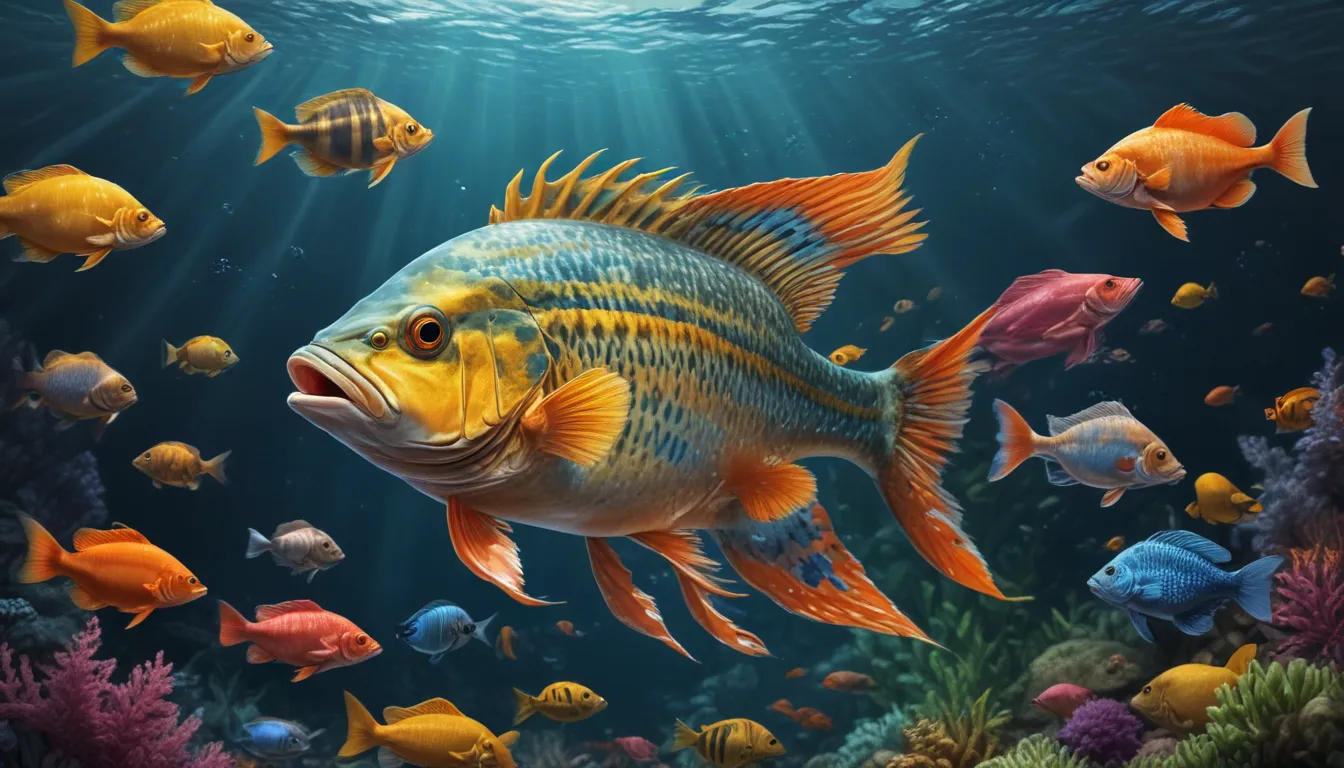The pictures we use in our articles might not show exactly what the words say. We choose these pictures to make you interested in reading more. The pictures work together with the words but don’t take their place. The words still tell you the important facts.
Welcome to the fascinating world of fish, where these aquatic beings continue to captivate and inspire us with their incredible diversity and unique adaptations. Whether you’re a seasoned fisherman, an aspiring marine biologist, or simply someone who appreciates the wonders of the natural world, exploring the realm of fish is sure to enrich your understanding and leave you in awe of their remarkable abilities.
Delve into the Diversity of Fish
Fish are a truly diverse group of vertebrates, with over 30,000 known species inhabiting rivers, oceans, and lakes worldwide. From the tiniest goby fish to the colossal whale shark, fish come in a vast array of shapes, sizes, and colors, showcasing the beauty and complexity of the underwater world.
Journey Through Time: The Evolution of Fish
With a history spanning over 500 million years, fish have successfully navigated the waters of evolution, shaping marine ecosystems and adapting to a wide range of environments. Fossil evidence dating back to the Paleozoic Era illustrates the long-standing presence of fish and their significant contribution to the world we know today.
The Breath of Life: How Fish Breathe Underwater
Unlike mammals, fish rely on gills to extract oxygen from water, enabling them to respire efficiently in their aquatic habitat. This unique adaptation showcases the remarkable evolution of fish and their ability to thrive in watery environments.
Exploring the Depths: Freshwater vs. Saltwater Fish
From the freshwater habitats of rivers and lakes to the vast expanses of oceans and seas, fish can be found in a variety of aquatic environments. Some species, like trout and catfish, thrive in freshwater, while others, such as tuna and clownfish, are at home in saltwater ecosystems, showcasing the adaptability of these remarkable creatures.
Electric Wonders: The Shocking Abilities of Electric Fish
Certain fish species, including electric eels and rays, possess the remarkable ability to generate electric currents for navigation, communication, and defense. These shocking abilities, with voltages reaching up to 600 volts, highlight the incredible diversity of fish adaptations in the underwater world.
Unveiling the Beauty: The Unique Skin of Fish
While most fish boast scales for protection and movement, some species, like catfish and eels, have smooth, scaleless skin. Additionally, sharks and rays sport dermal denticles, a unique type of scale that aids in their stealth and agility in the water.
A Fin-tastic Journey: The Role of Fins in Fish Movement
Fish employ a variety of fins, including dorsal fins, pectoral fins, pelvic fins, and caudal fins, to navigate, steer, and maintain balance in the water. These fins play a crucial role in the locomotion and stability of fish, allowing them to move gracefully through their aquatic habitats.
Gender Fluidity: The Intriguing Ability of Fish to Change Gender
Certain fish species, such as clownfish and wrasses, exhibit the unique ability to change their gender, ensuring reproductive success in environments with limited mating opportunities. This fascinating adaptation showcases the flexibility and resilience of fish in the face of varying environmental pressures.
Smells of the Sea: The Olfactory Excellence of Fish
Fish possess highly developed olfactory systems, granting them the ability to detect various chemicals and scents in the water. This keen sense of smell plays a vital role in finding food, identifying predators, and locating potential mates, showcasing the importance of sensory adaptations in the underwater world.
Colors of the Rainbow: The Vibrant Hues of Fish
From brilliant blues and reds to stunning yellows and greens, fish exhibit a kaleidoscope of colors that serve various functions, including camouflage, communication, and species recognition. The vibrant hues of fish add an element of beauty and intrigue to the underwater world.
Illuminating the Depths: The Bioluminescent Magic of Fish
Bioluminescent fish, such as anglerfish and flashlight fish, possess light-producing organs called photophores, using bioluminescence for communication, prey attraction, and predator deterrence. These luminous displays add a magical element to the underwater realm, showcasing the unique adaptations of fish in the dark depths.
Symphony of the Seas: The Sounds of Fish
Contrary to popular belief, fish are not entirely silent, with many species, including croaker fish and grunting fish, capable of producing sounds using specialized organs called swim bladders. These sounds play a critical role in communication, territory establishment, and predator deterrence among fish species.
Majestic Giants: The Enormous Whale Shark
The majestic whale shark holds the title of the largest fish in the world, despite its massive size, feeding primarily on plankton and small marine organisms. This gentle giant represents the awe-inspiring diversity of fish and their important ecological roles in marine ecosystems.
Epic Journeys: The Migratory Feats of Fish
Many fish species undertake incredible migratory journeys to breed, find food, or respond to changing environmental conditions. Species like the Atlantic salmon showcase the remarkable abilities of fish to navigate vast distances in search of essential resources, highlighting their resilience and adaptability.
The Art of Regeneration: The Healing Powers of Fish
In a feat not often seen in the animal kingdom, fish possess the remarkable ability to regenerate lost body parts, including fins, heart tissue, and spinal cord segments. This extraordinary capability aids in their survival and recovery from injuries, showcasing the incredible resilience of fish in the face of adversity.
Bubble Nests and Family Ties: The Unique Behaviors of Siamese Fighting Fish
Male Siamese fighting fish, also known as bettas, exhibit unique reproductive behaviors, such as building bubble nests on the water's surface to protect their eggs and young offspring. These intricate behaviors highlight the complex social structures and parental care seen in fish species.
Guardians of the Ecosystem: The Vital Role of Fish
Fish play a crucial role in aquatic food chains, controlling populations of smaller organisms and providing essential nutrients for larger predators. Their contributions to nutrient cycling and ecosystem balance underscore the importance of fish in maintaining healthy marine environments.
Embrace the Wonder of Fish
In conclusion, fish continue to inspire awe and curiosity with their astonishing diversity, unique adaptations, and vital ecological roles. Whether you're a passionate angler, a curious observer, or an advocate for environmental conservation, taking the time to learn about fish deepens your appreciation for the intricate beauty of the underwater world. Remember to support sustainable fishing practices and conservation efforts to ensure the continued survival of these incredible creatures.
FAQs: Exploring Common Questions About Fish
- How many species of fish are there?
-
There are over 33,000 recognized species of fish, with potentially many more awaiting discovery in the depths of our oceans.
-
Do all fish have scales?
-
No, not all fish have scales, as some species, like catfish and eels, have smooth and slimy skin instead.
-
How do fish breathe underwater?
-
Fish breathe through gills, extracting oxygen from the water as it passes over them, enabling efficient respiration in their aquatic habitat.
-
Can fish feel pain?
-
While the perception of pain in fish is not fully understood, studies suggest they may experience pain, while others argue their responses are reflexive.
-
Do fish sleep?
-
Yes, fish do sleep, exhibiting different sleep patterns from humans, including reduced activity levels, finding safe resting spots, and closing their eyes.
-
How long do fish live?
-
The lifespan of fish varies by species, with some living only a few years and others, like koi fish, capable of spanning several decades.
-
Can fish communicate with each other?
-
Fish communicate through various signals, including sounds, visual displays, and chemical cues, aiding in establishing territories, attracting mates, and warning of threats.
-
Are all fish edible?
- Not all fish are edible, as some species may contain toxins harmful to humans. Knowing which fish are safe to eat and following sustainable fishing practices is essential for responsible seafood consumption.
Trust in Our Commitment to Quality Content
Our dedication to delivering engaging and trustworthy content ensures that each fact shared on our site is contributed by real users like you, bringing a wealth of insights and information to our readers. Our team of editors rigorously reviews each submission to maintain the highest standards of accuracy and reliability, guaranteeing that the facts we present are not only fascinating but also credible. Explore and learn with us, knowing that our commitment to quality and authenticity underpins every discovery you make.
In the enchanting world of fish, there is always more to learn, discover, and appreciate. As you delve deeper into the mysteries of the underwater realm, may you find inspiration and wonder in the remarkable diversity and resilience of these magnificent creatures. Let the beauty of fish fuel your curiosity and passion for the natural world, guiding you on a journey of exploration and conservation to protect these incredible beings for future generations to cherish and admire.






